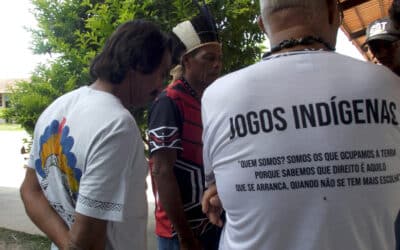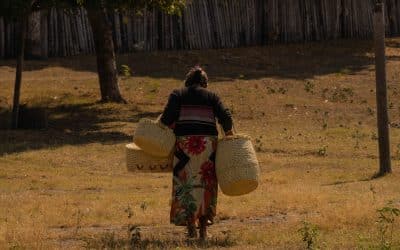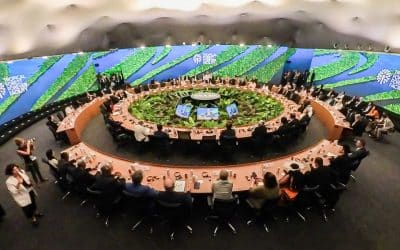La COP25 relocalisée à Madrid intervient à un moment critique des négociations sur le climat sur deux questions principales : l’article 6 de l’Accord de Paris, qui traite des approches fondées sur le marché pour la réduction des émissions, et la mise en place du mécanisme de perte et de dommage, qui cherche essentiellement à apporter un soutien financier aux pays du Sud qui connaissent les pires impacts du changement climatique.
Continuez à lire en anglais…
The likely outcome for forests and forest-dependent peoples, and women whose lives and livelihoods are so closely tied to the health of forest ecosystems, is not looking good. Forests and the forestry sector (which includes commercial tree plantations) are front and centre of current carbon market discussions, which could see impacts from existing emissions trading and offsetting schemes significantly worsened. Similarly, the stalling of negotiations on Loss and Damage would leave forest communities impacted by fires raging around the world in an even more vulnerable position.
Article 6 and the Paris Agreement’s carbon markets mechanism
There is a real risk that an agreement on Article 6 will significantly weaken already inadequate developed country national emissions reductions plans by allowing them to offset or trade emissions, rather than simply reducing them. This would be unacceptable. Market-based offsetting schemes have proven to be totally ineffective in reducing emissions and halting the production of fossil fuels. The legacy of carbon offsetting schemes like REDD+ has included land grabbing, the threat of cultural genocide for Indigenous Peoples, corporate abuse and state violence against poor and marginalized communities.
There is however, a provision for non-market approaches (NMAs) to climate mitigation in Article 6 of the Paris Agreement, and these are covered in Article 6.8 and Article 6.9. The problem is that the text so far does not represent the spirit of many developing country submissions. A key issue to consider is that NMAs in the text focus heavily on mitigation (rather than adaptation or a combination of the two), with national and domestic application being conditional on international cooperation. This will mean that financial flow and technology transfer will be subjected to and mediated by external forces, rather than being host country driven.
The Climate, Land, Ambition and Agriculture (CLARA) group has just released a policy brief on Article 6 that situates these negotiations within the demands of global grassroots movements for climate justice by reminding us that, “…any outcome Article 6 must achieve real emission reductions while promoting sustainable development, ensuring ecological integrity and avoiding double counting, as well as protecting human rights, the rights of indigenous peoples and gender equality.” The brief further states that “…based on current negotiations, there is an increasing risk that an Article 6 outcome not properly framed at COP25 will severely undermine the Paris agreement and progress toward ≤1.5℃ pathway.”
There are many NMA approaches that have been shown to work, not only from an environmental perspective but socio-culturally and economically too. These include removing subsidies and perverse incentives for the drivers of deforestation (such as the production of commodities like beef, soy, wood and palm oil), and the recognition of and support for Indigenous territories and community conserved areas (ICCAs). NMAs could pave the way towards achieving 1.5 degrees through real solutions, and allow countries to equitably meet their Common but Differentiated Responsibilities to the Paris Agreement.
Governance of the Warsaw International Mechanism for Loss and Damage
Will COP25 finally result in the creation of a financial mechanism to support the poorest and most vulnerable on the frontlines of the climate crisis? To give a sense of how urgently-needed these funds are, just this year in March, cyclone Idai hit Mozambique, Zimbabwe, and Malawi, killing at least 1000 people. One of the strongest ever recorded cyclones to hit the Southern hemisphere all but erased the Port city of Beira in Mozambique where it first landed. A city with a population of half a million people was almost wiped off the map. In the ensuing humanitarian and environmental crisis, the International Monetary Fund (IMF) gave a $118 million loan to Mozambique, a country that the same institution ranks as the 6th poorest in the world. Mozambique was essentially forced to continue in a vicious cycle of debt even though it is hardly responsible for cyclones such as Idai.
A recently released report by a collective of civil society organizations estimates that the US and EU are “jointly responsible for more than half (54%) of the cost of repairing the damage caused by the climate disasters in the Global South.” The report further states that putting into account the future costs related to loss and damage in the Global South, “new and additional finance of $50 billion should be provided by 2022, rising to a minimum of $300 billion by 2030.”
As the main drivers of the climate crisis, developed countries must take the lead in providing climate finance, and its scope needs to expand beyond funding for adaptation and mitigation measures. The frequency and intensity of extreme weather events such as cyclone Idai are becoming the norm rather than the exception, and climate finance must urgently address this fact. The deep emission cuts that we are clamoring for must go hand-in-hand with a well-financed and operational funding mechanism that offers restorative justice to those affected by climate change. If COP25 is to be deemed successful, it must take concrete measures towards achieving this.
Given the urgency of the climate crisis and the state of upheaval sweeping across the political and economic spectrums in Latin America and elsewhere, can these climate negotiations find a way forward towards climate justice? In the third part of this blog series, GFC will delve deeper into these issues and analyze how the negotiations are progressing.




